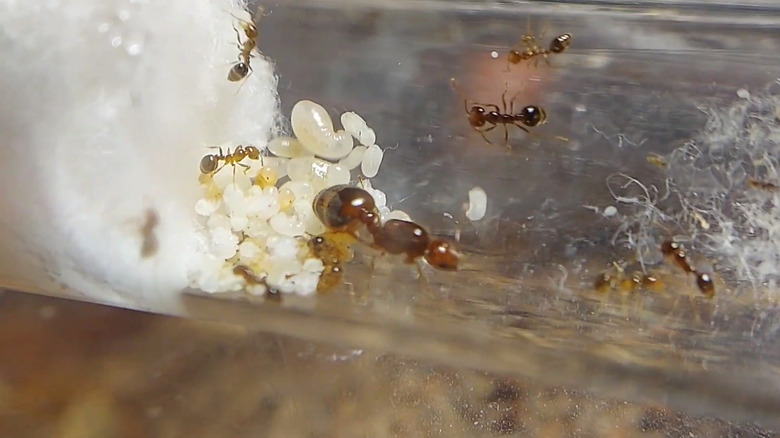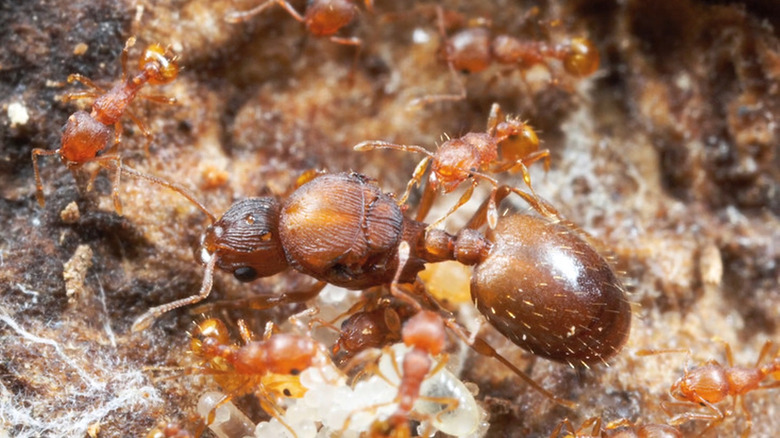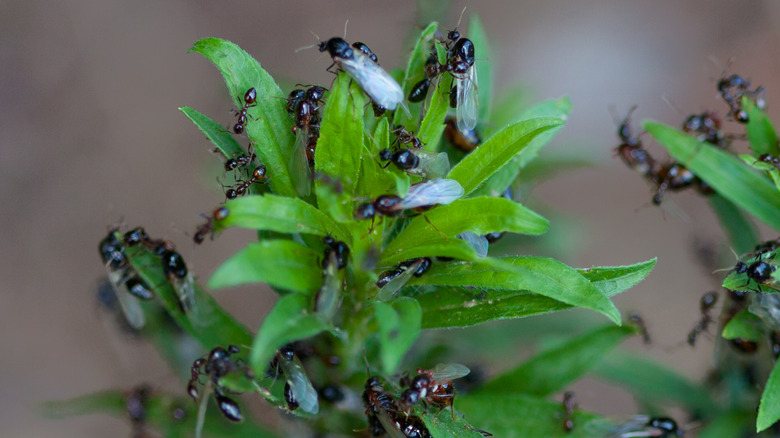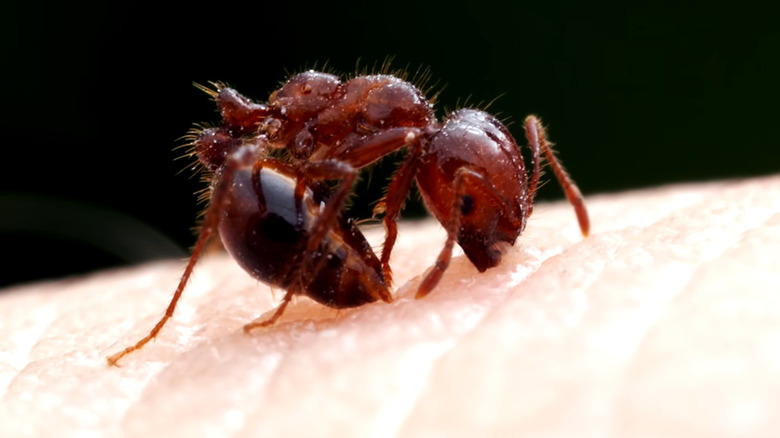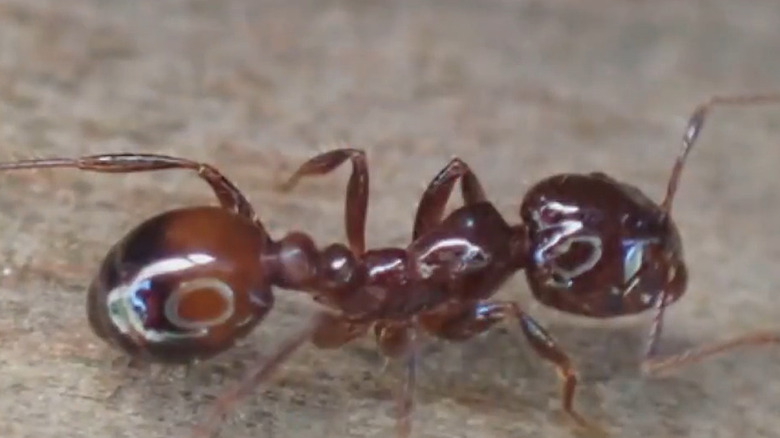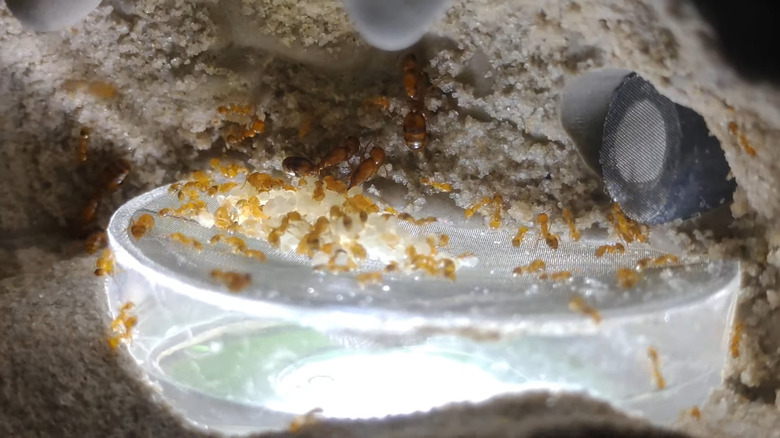7 Types Of Fire Ants You Might Find In Your Yard (& Why The Difference Matters)
Ouch! You were digging in your yard to plant, and you just felt a sting delivered courtesy of a fire ant. You may think of fire ants as just one type of ant capable of such a sting, but the truth is there are multiple species of fire ants calling the United States home. In addition to a concern about the actual sting they pack, you should consider what type of fire ant you have in your yard. The truth is, some are invasive imported fire ants, posing a serious risk to wildlife, pets, and humans, while other species are native. While all fire ants can deliver a sharp sting, it's invasive, imported species that concern authorities most. They urge the public to report any sightings so they know to quarantine and get rid of these fire ants.
The name "fire ant" originates from the stinging fiery sensation these species deliver. Both native and invasive fire ants can hurt and leave behind a welt. Their impact goes beyond pain, however. Individuals with a fire ant allergy can suffer from severe to fatal anaphylaxis. Depending on the species, fire ants can also damage crops. In some states, such as Texas, imported fire ants have displaced the native ant species, posing a major threat to biodiversity. Even homeowners without a vegetable garden can suffer from their damage, as mounds full of fire ants pop up in the yard, harming the landscape. It can be hard to determine exactly whether a fire ant is invasive or native at a glance, which is why it pays to know exactly what you've encountered in your yard.
Southern fire ant
The Southern fire ant, Solenopsis xyloni, extends through the Southern region and most of the Southwest, ranging as far as California. It lives outside in the soil, and may appear between sidewalk cracks. This ant species can measure up to 1/16 to 1/4 inch long with yellow or red bodies and a black abdomen. While the presence of the Southern fire ant can be a nuisance and leave a painful sting, it's a native species that won't harm the ecosystem. Avoid disturbing Southern fire ants as they can still show hostility, especially if you disrupt their mound.
Red imported fire ant
Serious stings come from the red imported fire ant, Solenopsis invicta, a non-native invasive species. Look for a dark reddish-brown ant measuring 1/8 to 1/4 inches long, sometimes with a dome-shaped hill. Report any sightings immediately to your local USDA (U.S. Department of Agriculture) office so they can investigate. According to researchers, the insect arrived on cargo ships from South America several decades ago, with its presence now recorded in 13 states, including North Carolina, Texas and California, as well as the U.S. territory of Puerto Rico. When approached, they may sting repeatedly, often in a swarm.
Little fire ants
True to their name, little fire ants (Wasmannia auropunctata) are very small, but have a powerful sting that leaves behind welts that may linger for weeks. Unfortunately, they're also very invasive and destructive, especially in Hawaii. They move very slowly, and may also be found in Florida and California. Distinguished by their yellow-brown body, little fire ants don't make hills or mounds like other ant species; instead, they prefer nesting in trees, electric boxes, and plants. These little hitchhikers can travel around the world undetected, carried by household items or even hiding in potted plants.
Black imported fire ant
Like the red imported fire art, the black imported fire ant (Solenopsis richteri) comes to the United States from South America, namely Argentina and Uruguay. A dark brown to black body with a golden patch on the abdomen indicates this fire ant. It, too, is highly invasive, but luckily has a limited range compared to its cousin, setting up its home in mounds. If you live within Mississippi, Alabama, or Tennessee, you may encounter it, and should report sightings immediately. Their bite is highly venomous, and can cause severe reactions, including painful white pustules, headaches, and nausea.
Tropical fire ants
Native to the Southeastern United States, the tropical fire ant (Solenopsis geminata) is also known as the "red ant." This species often resembles the invasive red imported fire ant (RIFA), however, the tropical fire ant is more hairy and less red than the RIFA with a larger head size. Tropical fire ants are highly aggressive and deliver a painful sting. They don't build traditional mounds like other fire ants. Pushing dirt into low, small hills, they often nest in flower boxes, potted plants, and other places near humans.
Hybrid fire ants
Research is still ongoing, but entomologists made a shocking discovery when they came across a hybrid combination of invasive black and red fire ants. Known simply as hybrid fire ants, these fierce insects are present in the same regions as their cousins, along with Virginia and Kentucky. The result is a more cold-tolerant ant that now survives further north than other species. This trait lets them colonize more areas quicker without retreating in cooler temperatures, posing more of a threat to humans.
Desert fire ants
Two species of native fire ant, Solenopsis aurea and Solenopsis amblychila, live in the Southwest United States. Their range differs by height — Solenopsis amblychila lives in areas with an elevation of 5,000 to 8,250 feet in Arizona, Texas, and southern New Mexico, while Solenopsis aurea is found below 6,600 feet. Both feature yellow to red coloring. They aren't as aggressive as other species, but will defend their nests which are often found under rocks. Solenopsis amblychila are also common in areas where homeowners make the mistake of overwatering their lawns.

